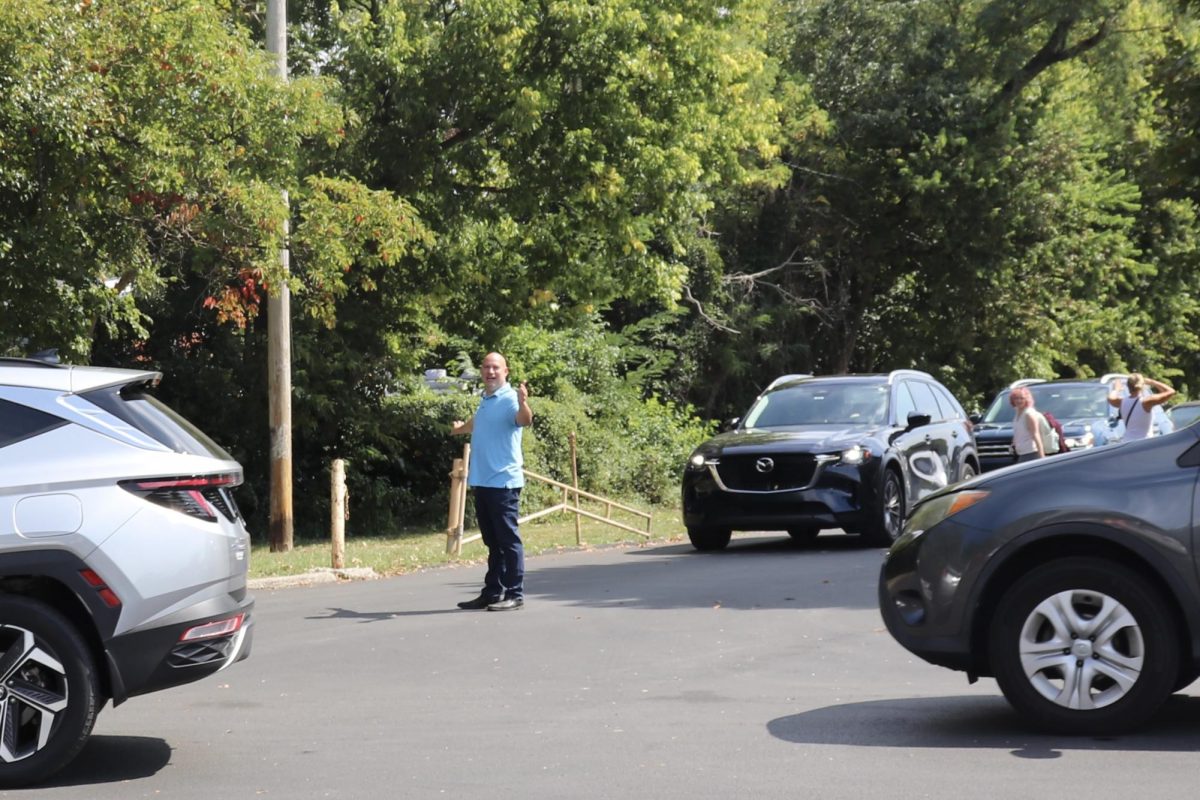As of this year, many Atherton students are going with a new flow by means of the guidance of new parking lot attendants. Student drivers and car riders alike are adapting to new extended regulations in the dismissal parking lot traffic flow. Now, in the afternoons, drivers may see attendants physically blocking some lanes of the parking lot and waving others along. However, traffic direction in some form is not entirely new to the dismissal process here at Atherton.
Mr. Hill is the assistant principal in charge of organizing transportation at Atherton. Hill provided further insight into how this system was developed and why it was put into place. This initial dismissal process was organized somewhat similar to the morning arrival traffic, with the primary purpose of streamlining the flow of traffic. The system involved redirecting drivers to split the flow of traffic between two points of exit onto the main road, relieving some stress on the right hand turn on Emerson. When school started, Mr. Hill would be at the right hand turn, directing traffic, and Ms. Marzian would be at the four way stop at Dundee and Emerson, where students can still occasionally see both.

“We actually started this last year when we had the guidance that the cones and directions laid out on the ground. Ideally, you’re having roughly 800 plus cars in that afternoon and so our goal is always to try to get every car out of the lot within 15 minutes,” Hill explained. “It just alleviates a lot of people from trying to go out the one way and also allows us enough time to get as many cars out as possible within a 15 minute span,” Hill continued.
Gideon Dunn (12) is entering her second year as a student driver at Atherton, and has seen these changes first-hand.
“There was a lot of confusion and disorderly behavior last year, as well as a lot of congestion,” Dunn noted. “It is clear the parking guards were put into place to manage this.”

However, Dunn notes that a majority of this congestion, in her experience, has actually come from the parent drivers. Dunn has witnessed this population demonstrate the most erratic displays of selfish and impatient driving, traits naturally intensified in the afternoon among all drivers. Consequently, despite the additional traffic guidance and guards installed this year, Dunn highlighted how little could actually be done with symptom treatments that fail to address the root problem- the attitude of drivers.
“I don’t see it making many differences for students and parents, it seems to mainly make people angry during the half hour after dismissal,” Dunn remarked.
Though Dunn said the traffic situation doesn’t concern her much until she is personally confronted with delays or backups, and she doesn’t encounter many complications, Dunn admitted she had found herself stuck in the parking lot for a half hour on occasion because of inconsiderate drivers and the scattered traffic flow. Additionally, Dunn noted that she has exclusively experienced complications with the traffic management in the afternoon, affirming that neither she nor any other student drivers experienced issues during arrival, suggesting this could be due to calmer drivers and the less rushed attitude of the morning.
The administrator’s 15-minute ideal proved difficult to live up to, especially due to Atherton’s unique infrastructure.
“The first year we did it, the parents that were parking back in that tennis court lot, where the co-op students were parking at, were stuck,” Hill continued. “They were back there for twenty-plus minutes.”
This is just one consequence of Atherton’s dismissal structure, in which cars from all lanes of the student parking lot stream into the single file line flowing out onto Emerson. In years prior, individuals relied on the merit system for entry into this line. However, it would soon backfire.
“The merit system, because of the lack of busing for a lot of those kids, wasn’t really merit based at that point,” Mr. Hill noted. “We had to stop traffic sometimes, so it went back and forth.”
As Hill explains, they prioritize the safety and efficiency of the dismissal system as it adjusts to the increased population at Atherton, compounded by the addition of sophomore student drivers and larger transportation dilemmas throughout JCPS.
Mr. Ellard is a history teacher here at Atherton, and serves as an attendant in the afternoon.
“It is related for sure,” Ellard said of Atherton’s traffic woes in light of the wider district’s hardships, “The lack of buses has meant more car riders plus with 200 to 300 new students, it has created a lot of traffic.”
The JCPS busing up set of 2023 and its aftershocks is now sparking ripple effects elsewhere in the transportation system as kids look for alternatives.
“The buses only go to resides students,” Mr. Hill noted. “In the past, magnet students were able to get a bus, but at this point, if you’re a magnet student, you don’t get a bus. So, the parents have to provide transportation.”
For a school like Atherton, which attracts many magnet applicants, this resulted in an inevitable surge in students turning to car transportation, either by becoming part of the burgeoning student driver population or by means of their parents. Especially for Atherton, nestled in a highly walkable residential community, many of the students within reasonable distance to the school were already walking. Thus, those affected by the loss of busing are truly dependent on car transportation.
Despite these broader concerns currently facing the better part of the district, Atherton is doing a respectable job tackling them relative to other schools.
“Our parking lot, especially for a student parking lot, is not as big as a lot of other schools have,” Mr. Hill conceded. “We roughly have 230 spots for students to park in. With the amount of car riders that we have coming in and getting out, we’re doing a really good job.”
As a school with a smaller student parking lot, in a compact, residential area, the efficiency Atherton’s parking staff has created can be traced back to effective organization of traffic flow. As administrators continue to strive towards their goals as they attempt to accommodate more cars than ever, many drivers are still left wondering if the most efficient solution is always the most fair.

































